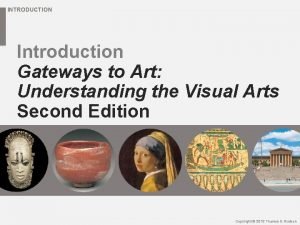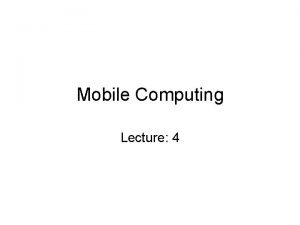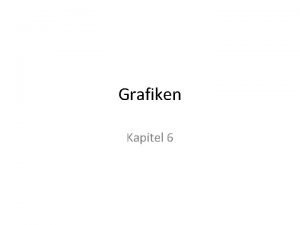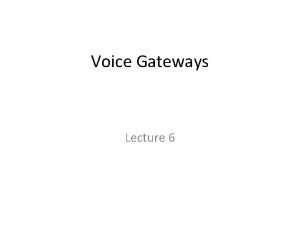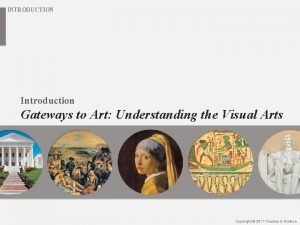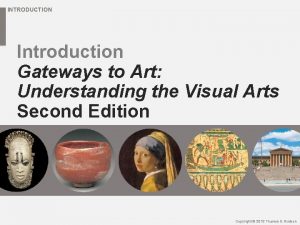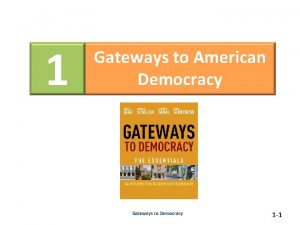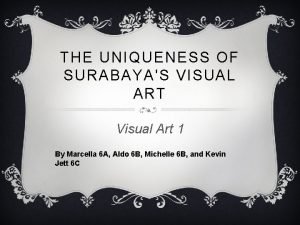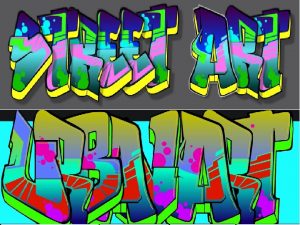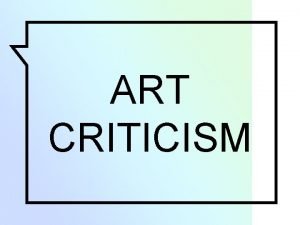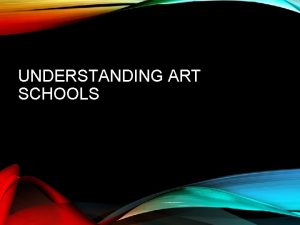INTRODUCTION Introduction Gateways to Art Understanding the Visual














































- Slides: 46

INTRODUCTION Introduction Gateways to Art: Understanding the Visual Arts Copyright © 2011 Thames & Hudson

INTRODUCTION What Is Art? § Art communicates ideas and emotions by visual means: it is a form of language § Art helps us see the world in new and exciting ways § Art is not made of a defined, prescribed set of media § Art has many purposes Gateways to Art: Understanding the Visual Arts, Debra J. De. Witte, Ralph M. Larmann, M. Kathryn Shields

0. 1 The Journey of the Sun God Re, detail from the inner coffin of Nespawershefi, Third Intermediate Period, 990– 969 BCE. Plastered and painted wood. Fitzwilliam Museum, Cambridge, England

INTRODUCTION The Journey of the Sun God Re § Sun god Re in the underworld at night § Reflects importance of rivers in Egypt § Refers to Egyptian beliefs about the afterlife Gateways to Art: Understanding the Visual Arts, Debra J. De. Witte, Ralph M. Larmann, M. Kathryn Shields

0. 2 William G. Wall, Fort Edward, from The Hudson River Portfolio, 1820. Hand-colored aquatint, 14½ × 21⅜”

INTRODUCTION William G. Wall, Fort Edward § 1820. Hand-colored aquatint (print) from a watercolor § Painting by William G. Wall; print by John Hill u u Landscape with one small human figure: a native American woman. Conveys the passing of the native American way of life as a result of the arrival of European settlers Reflects nation-building and expansion of 19 th-century America Gateways to Art: Understanding the Visual Arts, Debra J. De. Witte, Ralph M. Larmann, M. Kathryn Shields

0. 3 Louise Nevelson, White Vertical Water, 1972. Painted wood, 18 × 9’. Solomon R. Guggenheim Museum, New York

INTRODUCTION Louise Nevelson, White Vertical Water § Not an immediately recognizable portrayal of its subject: river or waterfall, and fish § By making us look closely, artist evokes sensations of water falling and fish swimming Gateways to Art: Understanding the Visual Arts, Debra J. De. Witte, Ralph M. Larmann, M. Kathryn Shields

INTRODUCTION Where Is Art? § Art is in many places: u Objects as diverse as coffins or books u Museums u Parks and public places u Our homes Gateways to Art: Understanding the Visual Arts, Debra J. De. Witte, Ralph M. Larmann, M. Kathryn Shields

0. 4 Simon Rodia, Watts Towers, 1921– 54. Seventeen mortar-covered steel sculptures with mosaic, 99½’ high at tallest point. 1761– 1765 East 107 th Street, Los Angeles, California

INTRODUCTION Simon Rodia, Watts Towers § Made by a construction worker, not a trained artist § Media: found materials (steel rods, pipes, wire mesh, mortar, broken glass, and pottery) § Named Nuestro Pueblo by Rodia but now called Watts Towers § Originally viewed as controversial, but now a National Historic Landmark Gateways to Art: Understanding the Visual Arts, Debra J. De. Witte, Ralph M. Larmann, M. Kathryn Shields

0. 5 Thomas Jefferson, Virginia State Capitol Building, 1785– 8, Court End District, Richmond, Virginia

INTRODUCTION Thomas Jefferson, Virginia State Capitol Building § 1785– 8 § Civic building modeled on Roman temple in Nîmes, France § Used symbolic power of ancient Rome to communicate strength of the Republic and its institutions Gateways to Art: Understanding the Visual Arts, Debra J. De. Witte, Ralph M. Larmann, M. Kathryn Shields

INTRODUCTION Who Makes Art? § A single individual or many § Artists or artisans – craftspeople also make beautiful and useful works § Famous or anonymous § Not all artists make their art themselves § Making of art also influenced by patrons who commission it § Can be affected also by training (or lack of): artist as follower of tradition or as innovative genius Gateways to Art: Understanding the Visual Arts, Debra J. De. Witte, Ralph M. Larmann, M. Kathryn Shields

0. 6 Jeff Koons, Rabbit, 1986. Stainless steel, 41 × 19 × 12”. Edition of 3 and artist’s proof

INTRODUCTION Jeff Koons, Rabbit § 1986. Stainless steel § Jeff Koons had the idea u His employees made the artwork Gateways to Art: Understanding the Visual Arts, Debra J. De. Witte, Ralph M. Larmann, M. Kathryn Shields

0. 7 Tea bowl, 16 th century. Stoneware with red glaze (Karatsu ware), 3 × 19⅞”. Indianapolis Museum of Art

INTRODUCTION Tea bowl § “High art” or craft? § In Japan ceramic tea bowls highly valued § Appreciated for subtle variations of color and tactile sensations § Artist followed a long tradition and well-established methods of working and making Gateways to Art: Understanding the Visual Arts, Debra J. De. Witte, Ralph M. Larmann, M. Kathryn Shields

0. 8 Leonardo da Vinci, Mona Lisa, 1503. Oil on wood, 30⅜ × 20⅞”. Musée du Louvre, Paris, France

INTRODUCTION Leonardo da Vinci, Mona Lisa § Mona Lisa u u Made in an era and in a culture that valued individual ingenuity Portrait not simply a likeness: a meditation on the human soul § Leonardo da Vinci (1452– 1519) u Artist as genius: visual artist, engineer, scientist Gateways to Art: Understanding the Visual Arts, Debra J. De. Witte, Ralph M. Larmann, M. Kathryn Shields

0. 9 Titian, Isabella d’Este, 1536. Oil on canvas, 40¼ × 25¼”. Kunsthistorisches Museum, Vienna, Austria

INTRODUCTION Titian, Isabella d’Este § Art may not be the result of the work of the artist alone: patrons, collectors, dealers, and critics all help determine what art is made § Isabella d’Este, Marchesa of the city of Mantua, Italy funded many artists u u Her money and taste determined what art was produced This portrait was painted when she was in her sixties but because of her influence the artist showed her flatteringly as a youthful beauty Gateways to Art: Understanding the Visual Arts, Debra J. De. Witte, Ralph M. Larmann, M. Kathryn Shields

INTRODUCTION The Value of Art § Value can mean sale price in money § Value can mean rarity or uniqueness § Fame of the artist can influence value § Objects can have a ceremonial or spiritual value § Art can be valuable because it expresses a society’s cherished ideals and identity § Art can be valued for its beauty and power to inspire awe Gateways to Art: Understanding the Visual Arts, Debra J. De. Witte, Ralph M. Larmann, M. Kathryn Shields

0. 10 Gustav Klimt, Adele Bloch-Bauer, 1912. Oil on canvas, 6’ 2⅞” × 3’ 11¼”. Private collection

INTRODUCTION Gustav Klimt, Adele Bloch-Bauer § Painted by famous artist: Gustav Klimt (1862– 1918) § Wealthy patrons commissioned such portraits § Portrait sold for $135 million in 2006 (much more than artist was ever paid in his lifetime) u u u Value increased because of painting’s controversial history: looted by Nazis and became subject of a lawsuit Also by 2006 had become rarer: artist no longer alive and fewer of his works available to buy An artist’s achievement often comes to be better appreciated after his or her lifetime, as it is studied and stands the test of time Gateways to Art: Understanding the Visual Arts, Debra J. De. Witte, Ralph M. Larmann, M. Kathryn Shields

0. 11 Rembrandt van Rijn, Self-portrait, 1630. Oil on copper, 6⅛ × 4¾”. Nationalmuseum, Stockholm, Sweden

INTRODUCTION Perspectives on Art: Robert Wittman What Is the Value of an Artwork? § Monetary value of art = price paid by a willing buyer to a willing seller § Stolen art is worth much less: 10% or less of free market value (it is very hard to resell) § Rembrandt, Self-portrait u u u Stolen from Swedish National Museum in Stockholm in 2000 Painting was not only by great artist but also very rare: only known portrait by Rembrandt that is painted on copper Thieves tried to resell it for $250, 000 – less than one percent of its market value – in 2005; painting was thereby recovered by police Gateways to Art: Understanding the Visual Arts, Debra J. De. Witte, Ralph M. Larmann, M. Kathryn Shields

0. 12 The Lincoln Memorial statue by Daniel Chester French, 1920. Marble, 19’ high. The Mall, Washington, D. C.

INTRODUCTION Daniel Chester French, The Lincoln Memorial statue § Memorial dedicated 1922. Statue made of marble § Lincoln Memorial u Honors a great president – Abraham Lincoln u Symbolizes and celebrates American values and identity u Work of three artists: architect Henry Bacon, sculptor Daniel Chester French, mural painter Jules Guerin Gateways to Art: Understanding the Visual Arts, Debra J. De. Witte, Ralph M. Larmann, M. Kathryn Shields

0. 13 Johannes Vermeer, Girl with a Pearl Earring, c. 1665. Oil on canvas, 17½ × 15⅜”. Mauritshuis, The Hague, Netherlands

INTRODUCTION Perspectives on Art: Tracy Chevalier Art Inspires a Novel and a Movie § Portrait titled Girl with a Pearl Earring, painted by Dutch artist Johannes Vermeer, c. 1665 § Vermeer portrait inspired Tracy Chevalier’s novel of the same name, which was then made into a movie in 2003 u u u Painting is mysterious: is the girl happy or sad? A single, flickering moment captured in permanent oil paint on canvas A static painting but girl never seems to remain the same Gateways to Art: Understanding the Visual Arts, Debra J. De. Witte, Ralph M. Larmann, M. Kathryn Shields

INTRODUCTION Censorship of Art § Art can be very powerful: it can challenge or offend § Art can be censored for many reasons: u Because it is pornographic u Because it offends religious beliefs u Because viewers object to its political message u Because it expresses values that others do not share Gateways to Art: Understanding the Visual Arts, Debra J. De. Witte, Ralph M. Larmann, M. Kathryn Shields

0. 14 Marc Quinn, Self, 1991. Blood (artist’s), stainless steel, perspex, and refrigeration equipment, 81⅞ × 24¾”. Private collection

INTRODUCTION Marc Quinn, Self § Self was part of 1999 Sensation exhibition at Brooklyn Museum, which showed controversial works § Many people objected to another work on show, Chris Ofili’s The Holy Virgin Mary, for religious reasons § Mayor Giuliani demanded that work be removed but the museum refused § Giuliani attempted to evict museum from its building and withhold funding § Federal court ruled for the museum Gateways to Art: Understanding the Visual Arts, Debra J. De. Witte, Ralph M. Larmann, M. Kathryn Shields

0. 15 Otto Dix, Kriegeskrueppel (War Cripples), 1920. Drypoint, 12¾ × 19½” (sheet size). MOMA, New York

INTRODUCTION Otto Dix, Kreigeskrueppel (War Cripples) § Otto Dix (1891– 1969) served in the army during the World War I and recorded his grim experiences of war in his art § Nazi regime in 1930 s Germany objected to modern art that did not promote its goals § Nazis u u u Confiscated 21, 500 works of art and destroyed many Fired artists and museum directors from jobs Attempted to ridicule other works, including Dix’s drawing, in the “Degenerate Art” Exhibition in 1937 • But five times more visitors went to Degenerate Art Exhibition than to a show of Nazi-approved “Great German Art” that was on at the same time Gateways to Art: Understanding the Visual Arts, Debra J. De. Witte, Ralph M. Larmann, M. Kathryn Shields

INTRODUCTION Why Do We Study Art? § There are many ways to see and interpret a work of art § We can analyze art as visual language § What can historical or social context tell us about art? § Alternatively, can art teach us something about history and culture? § Does art reflect its creator’s opinions? Gateways to Art: Understanding the Visual Arts, Debra J. De. Witte, Ralph M. Larmann, M. Kathryn Shields

0. 16 Winslow Homer, Prisoners from the Front, 1866. Oil on canvas, 24 × 38”. Metropolitan Museum of Art, New York

INTRODUCTION Winslow Homer, Prisoners from the Front § Visual analysis: how does the artist direct the viewer’s eye, what colors did he choose, and why? § How does the painting reflect its historical moment? § How does the painting reflect the artist’s views? § What can we learn by comparing it with other paintings of war? Gateways to Art: Understanding the Visual Arts, Debra J. De. Witte, Ralph M. Larmann, M. Kathryn Shields

0. 17 Eugène Delacroix, The Massacre at Chios, 1824. Oil on canvas, 13’ 8” × 11’ 7⅜”. Musée du Louvre, Paris, France

INTRODUCTION Eugène Delacroix, The Massacre at Chios § Eugène Delacroix (1798– 1863) was a French painter who worked in the Romantic style § Historical context: conflict between Greeks and Turks. The painting depicts a massacre of Greek people by Turks (the event was a reprisal for Greek destruction of Turkish mosques) § Is Delacroix’s painting objective or biased? § How does the painting reflect the opinions of its audience, who were Europeans? § How does the artist influence our own reaction to the painting? Gateways to Art: Understanding the Visual Arts, Debra J. De. Witte, Ralph M. Larmann, M. Kathryn Shields

0. 18 Carved ivory mask-shaped hip pendant, mid-16 th century. Ivory inlaid with iron and bronze, 9⅝ × 5 × 2⅜”. British Museum, London, England

INTRODUCTION Carved ivory mask-shaped hip pendant, Benin, Africa § Viewer’s eye directed downward to concentrate on the woman’s beauty § Made of rare materials for a wealthy king § Now displayed in a museum case but originally decoration on a king’s belt § Symbolism of Portuguese heads and mudfish carved around the top of the headdress, once we are aware of it, adds to our appreciation of the pendant Gateways to Art: Understanding the Visual Arts, Debra J. De. Witte, Ralph M. Larmann, M. Kathryn Shields

INTRODUCTION To find out more about other beautiful artworks created by the master craftsmen from these parts of Africa watch: Video: The Master Sculptors of Benin and Ife Click to launch the video Gateways to Art: Understanding the Visual Arts, Debra J. De. Witte, Ralph M. Larmann, M. Kathryn Shields

INTRODUCTION This concludes the Power. Point slide set for the Introduction Gateways to Art: Understanding the Visual Arts By Debra J. De. Witte, Ralph M. Larmann, M. Kathryn Shields Copyright © 2011 Thames & Hudson Power. Points developed by Creative. Myndz Multimedia Studios

INTRODUCTION Picture Credits for Introduction 0. 1 Fitzwilliam Museum, University of Cambridge/Bridgeman Art Library 0. 2 Spencer Collection, New York Public Library, Astor, Lenox and Tilden Foundations 0. 3 Solomon R. Guggenheim Museum, New York, Gift, Mr. and Mrs. James J. Shapiro, 85. 3266. Photo David Heald © Solomon R. Guggenheim Foundation. © ARS, NY and DACS, London 2011 0. 4 © Nik Wheeler/Corbis 0. 5 © Ian Dagnall/Alamy 0. 6 © Jeff Koons 0. 7 Indianapolis Museum of Art, Gift of Charles L. Freer/Bridgeman Art Library 0. 8 Musée du Louvre, Paris 0. 9 Kunsthistorisches Museum, Vienna 0. 10 Private Collection 0. 11 Photo © Erik Cornelius/Nationalmuseum, Stockholm 0. 12 © Ian Dagnall/Alamy 0. 13 Mauritshuis, The Hague 0. 14 Photo Marc Quinn Studio. Courtesy White Cube. © the artist 0. 15 Publisher Heinar Schilling, Dresden. Printer unknown. Edition 15. Museum of Modern Art, New York, Purchase, Acc. no. 480. 1949. Photo 2011, Museum of Modern Art, New York/Scala, Florence. © DACS 2011 0. 16 Metropolitan Museum of Art, Gift of Mrs. Frank B. Porter, 1922, Acc. no. 22. 207. Photo Metropolitan Museum of Art/Art Resource/Scala, Florence 0. 17 Musée du Louvre, Paris 0. 18 André Held /akg-images Power. Points developed by Creative. Myndz Multimedia Studios
 Gateways to art 2nd edition
Gateways to art 2nd edition Cisco pstn
Cisco pstn Middleware and gateways in mobile computing
Middleware and gateways in mobile computing Gateways to opportunity
Gateways to opportunity Examples of subject gateways
Examples of subject gateways Bpmn gateways
Bpmn gateways Firewall a
Firewall a Tdm pstn
Tdm pstn Protocol gateways
Protocol gateways Protocol gateways
Protocol gateways Application level gateways
Application level gateways Visual understanding environment
Visual understanding environment Higher expressive evaluation
Higher expressive evaluation Understanding standards higher art
Understanding standards higher art Apa yang dimaksud dengan pemrograman konvensional?
Apa yang dimaksud dengan pemrograman konvensional? Hình ảnh bộ gõ cơ thể búng tay
Hình ảnh bộ gõ cơ thể búng tay Lp html
Lp html Bổ thể
Bổ thể Tỉ lệ cơ thể trẻ em
Tỉ lệ cơ thể trẻ em Gấu đi như thế nào
Gấu đi như thế nào Chụp tư thế worms-breton
Chụp tư thế worms-breton Hát lên người ơi alleluia
Hát lên người ơi alleluia Môn thể thao bắt đầu bằng từ đua
Môn thể thao bắt đầu bằng từ đua Thế nào là hệ số cao nhất
Thế nào là hệ số cao nhất Các châu lục và đại dương trên thế giới
Các châu lục và đại dương trên thế giới Công thức tính độ biến thiên đông lượng
Công thức tính độ biến thiên đông lượng Trời xanh đây là của chúng ta thể thơ
Trời xanh đây là của chúng ta thể thơ Mật thư tọa độ 5x5
Mật thư tọa độ 5x5 Phép trừ bù
Phép trừ bù độ dài liên kết
độ dài liên kết Các châu lục và đại dương trên thế giới
Các châu lục và đại dương trên thế giới Thơ thất ngôn tứ tuyệt đường luật
Thơ thất ngôn tứ tuyệt đường luật Quá trình desamine hóa có thể tạo ra
Quá trình desamine hóa có thể tạo ra Một số thể thơ truyền thống
Một số thể thơ truyền thống Cái miệng xinh xinh thế chỉ nói điều hay thôi
Cái miệng xinh xinh thế chỉ nói điều hay thôi Vẽ hình chiếu vuông góc của vật thể sau
Vẽ hình chiếu vuông góc của vật thể sau Thế nào là sự mỏi cơ
Thế nào là sự mỏi cơ đặc điểm cơ thể của người tối cổ
đặc điểm cơ thể của người tối cổ Thế nào là giọng cùng tên? *
Thế nào là giọng cùng tên? * Vẽ hình chiếu đứng bằng cạnh của vật thể
Vẽ hình chiếu đứng bằng cạnh của vật thể Phối cảnh
Phối cảnh Thẻ vin
Thẻ vin đại từ thay thế
đại từ thay thế điện thế nghỉ
điện thế nghỉ Tư thế ngồi viết
Tư thế ngồi viết Diễn thế sinh thái là
Diễn thế sinh thái là Dot
Dot
